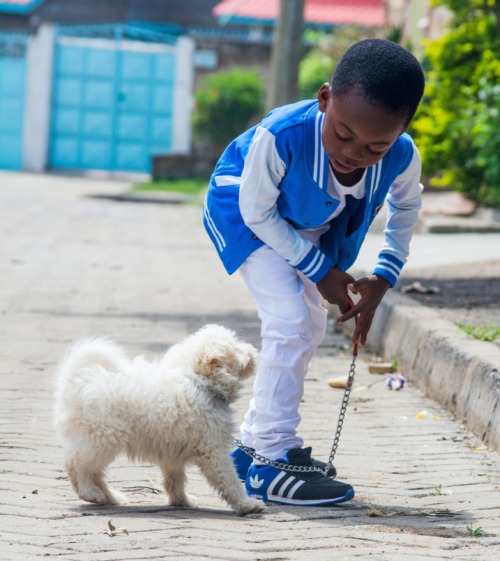
So, you’re thinking about adding a baby and maybe even a dog to the family. Dogs are companions for life, but are still animals with sometimes unpredictable instincts. Children come with their own dose of unpredictability and may have trouble recognizing signals from your dog as they’re developing. In this article, a companion piece on introducing your child to your cat, our walker Larkin guides us through making sure the time your child spends with your dog is a pleasant one and ensures that you embark on this journey equipped with tools for success!
Having a dog before a child
If you have a dog before a child, that allows you to get to enjoy the dog one on one and discover all of its quirks. With a dog already in the house, this allows you to plan out adjustments to your dog’s life around a child ahead of time. Children can also get an immune system benefit from having pets and will be less likely to develop asthma or various allergies.
But can an old dog learn new tricks? Older dogs might take longer to learn how to be around children, so it’s best to start training them for this as soon as possible. A dog can invariably feel displaced by the new family member, so still try and find some one-on-one time for you and your dog.
Getting a puppy after having a child
If you get a new puppy, they and your child can grow up together! Your dog will come to understand that your infant is a part of their family and learn who is a part of their pack before it enters its later puppy stages. As an additional benefit, a new puppy can give your child the opportunity to learn how to take care of animals from an early age.
However, puppies require lots of hands-on time, almost as much as a new baby. In their early stages, puppies will play with their mouths just as they would with their littermates. While this is also how they learn bite inhibition, i.e., when a bite is too hard, make sure to supervise your puppy when they’re around your child. If a bite happens (see Common Trouble Spots below for what to do in case of biting), it is a great time for your child to introduce a toy for them to play with instead.
Getting an adult dog after having a child
If the prospect of raising a child at the same time as a puppy is too much to take on, adopting a socialized adult dog might be an easier option. In this case, familiarize your child with correct socializing with dogs as much as possible before adopting a pet. Demonstrate to them how to pet dogs properly so that they will understand rough play is not okay. Dogs who might not be used to rough handling could become anxious or fearful. On the pet’s end, use positive reinforcement techniques to get them used to typical behaviors of small children, such as some rough handling, loud sounds, and crawling—the sight of a small human crawling on their belly can be strange to a dog!
Playtime between your dog and child
Aim to ensure that interactions between your pet and your child are as positive as possible. Have your child give your dog treats for good behavior and basic commands. This will reinforce the dog’s positive feelings towards your child. Teach your child how to read your dog’s body language for fear, overstimulation, and aggression. A great sign is if your dog invites your child to play by presenting a toy! Always check in with both of them to be sure neither is becoming overstimulated.
Never force interactions if either party doesn’t seem interested or is actively trying to remove themselves from the situation. Dogs’ personal thresholds change on a daily or even hourly basis. You can train your dog to tolerate some heavy petting and hugging as a safeguard, but you should teach your child to treat animals gently.
Here’s a simple code of conduct for your child to follow:
- Don’t incessantly follow and chase after your dog.
- Don’t pull the dog’s tail or hair.
- Leave the dog’s food and water bowls alone, especially if they show resource-guarding.
- Don’t steal your dog’s toys
- Try and keep away from pets if you’re having a tantrum—it can cause dogs to become frazzled.
Creating a “break room” for your pet
Dogs need to occasionally take breaks from socializing. If you see your dog removing itself from a situation, it is crucial you let them have their space. Designate a place in your home as your pet’s refuge, and make sure never to use it as a punishment. A favorite room of theirs can be closed off for their use or separated by a baby gate, which can allow your child and dog to play with each other without having to directly interact.
Your child and unfamiliar dogs
Teach your children that not all dogs are not like yours. It sounds simple, but your child will most likely try to interact with other dogs the same way they do with your family pet! The best lesson you can teach your child is to always ask before touching another person’s dog. And of course, supervise each interaction.
Common trouble spots: Begging, Jumping, and Snapping
When dogs beg at the table, they can create a symbiotic relationship with your kid if they get fed. Remove the dog from the eating area during mealtime if they’re begging.
Dogs can push children over or jump up on them when they’re excited. To help with this, teach your child how to give sit and down commands for when your dog is getting too excited or getting ready for a walk. Ignoring a dog until they stop jumping up is also effective. If they need to, teach your child to find high ground if the dog jumps too much.
If your dog growls or snaps at your child, separate the child and dog and remove the point of conflict, such as the food bowl or toy. Baby gates and crates are your friends when you see potentially tense situations developing. It may be useful to train “Go away” commands, where the dog will understand to make a retreat to a predesignated area. If you take the child away too often in response to the dog’s growling or aggression, it could reinforce to the dog that whenever they want the child to go away then they should growl and you’ll swoop in. Make sure to consult with your vet and/or a behavior specialist if you have any questions or if behavior problems persist.
Raising a child while raising a dog can be one of the most rewarding challenges you take on. It’s an important time to teach your child how to be kind and gentle towards animals and to ensure as many interactions are as positive as possible.
Thank you, Larkin, for your help on how to build a friendship between your child and your dog! Windy City Paws is a Fear Free Chicago dog walker and petsitter committed to providing helpful information to Chicago dog owners through its blog.v
Written for Windy City Paws by Larkin S.






